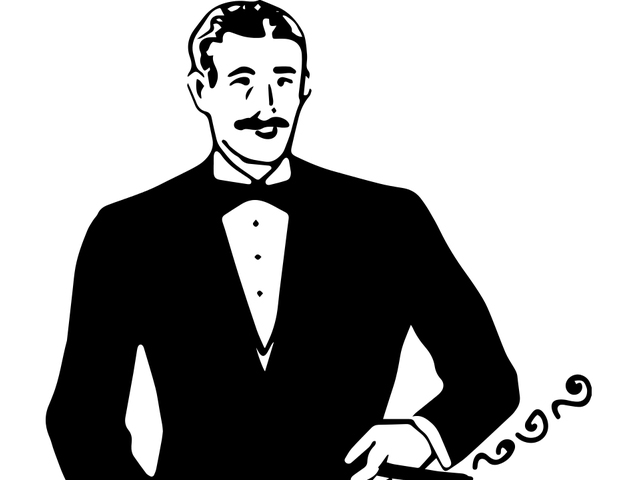It has been widely praised for its artistic choices, superb acting, screenplay and score, was nominated for ten Academy Awards and won three Golden Globes (including Best Comedy), but is The Artist truly deserving of such accolades, or is it just an overhyped, pretentious gimmick? As cynical as I sometimes am, I entered the theater worrying that The Artist would turn out to be one of those films that critics love for its stylistic choices, but that sends most people to sleep. I worried that nostalgia and the excitement over seeing something different — a film that dared to be black-and-white and mostly silent in the world of modern 3-D blockbusters — might be blinding critics. I assumed that there wouldn’t be any more to it and that the film as a whole wouldn’t be deserving of such honors. I was proven completely wrong.
Directed by Michel Hazanavicius, the movie takes place between 1927 and 1932 and follows the antics of a much loved silent film star, George Valentin (played by Jean Dujardin). At the onset of the film, George falls for an extra named Peppy Miller (Bérénice Bejo) who is just breaking into the business. The story of their troubled romance continues throughout the rest of the film but, despite what Fandango’s plot synopsis led me to believe, it really isn’t the film’s central focus. At its core, The Artist is a movie about what happens to a man when the world he knows ceases to exist, when it outgrows him and his pride won’t allow him to adapt to the times. Two years after George’s initial meeting with Peppy, she has skyrocketed along with the popularity of the newly invented talkies. Meanwhile, George suddenly finds his talents and life’s work to be thought of as an inferior relic of the past. His stubborn insistence that the talkies are just a fad, along with the public’s desire for new faces, leads him on a self-destructive path as he slowly loses everything he cared about.
I’m sure there are those who will dismiss The Artist as soon as they hear that it’s a silent, black-and-white film. As someone who has had to watch a fair number of silent movies in my film classes, I completely understand why some moviegoers would immediately assume that such a film would be boring. That’s actually a big part of what impressed me so much about the film. Without any dialogue, The Artist managed to keep me completely entertained from start to finish. There are no long, drawn out or confusing parts, largely due to Ludovic Bource’s magnificent score. It ranged from catchy and peppy to appropriately dark when the scenes called for it. The score kept viewers awake, alert and invested in the drama. Despite being labeled a silent film, The Artist actually uses sound in some interesting ways. A major theme of the story is the interplay between sound and its absence. In one particularly interesting scene, sound was used to dramatically show George’s inner fears about the rise of sound within the film industry, as he alone cannot be heard.
Though the directing and stylistic choices were incredibly well-executed, the real reason that this film works is Dujardin’s performance as George. His acting is often over-the-top, but that’s exactly what works in a silent movie, and at the appropriate points, he is subtle. At the beginning of the film I was struck by just how perfectly Dujardin portrayed George’s sense of pure, childlike joy. He made it clear that George loved every minute of his work and reveled in his fame. As the film progressed it was unnerving to see how Dujardin could bring such a joyful character to a dark place. As Peppy, Bejo played quite well off of Dujardin. She was able to capture a magnetic character that was both sassy and lovable. I particularly enjoyed her character’s confidence. She was smart, in control and did what she needed to get her way but she never lost her innate sweetness.
Dujardin and Bejo had excellent chemistry together. The film’s acting and writing is such that the silent nature of the film does not hinder their connection at all. Dialogue is unnecessary because the two characters seem so comfortable and at home in each other’s presence. Though I still feel as though they fell for each other a bit too hard, too fast (in typical Hollywood fashion), I was glad that there were time jumps to break up the progression of their relationship.
As much as I loved The Artist, it isn’t a perfect film. Though it’s labeled a comedy-drama, I’d say its comedy is lacking in some ways. There are fun gags throughout the film (many of which involve George’s lovable dog) but these are mostly cute and smileworthy, not laugh-out-loud funny. More troublesome than the comedy, however, is George’s overall character. I wouldn’t be surprised if some people found him slightly annoying near the end of the film, if not downright unlikable. His pride continuously makes things worse and worse for him. The choices he makes later in the film are upsetting to watch, and I can see how it might become annoying for some viewers.
Despite these flaws, the film overall is expertly crafted — a very different experience than most cinema today. It’s an entertaining ride that will have you feeling nostalgic for a time when films were still a new and exciting phenomenon.









